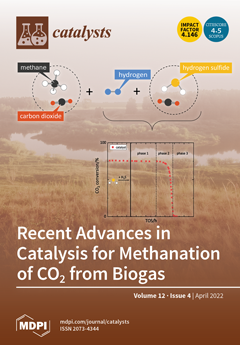The large amount of nitrogen oxides (N
2O, NO, NO
2, etc.) contained in the flue gas of industrial adipic acid production will seriously damage the environment. A designed binuclear Cu-ZSM-5 catalyst can be applied to decompose N
2O and
[...] Read more.
The large amount of nitrogen oxides (N
2O, NO, NO
2, etc.) contained in the flue gas of industrial adipic acid production will seriously damage the environment. A designed binuclear Cu-ZSM-5 catalyst can be applied to decompose N
2O and reduce NO and NO
2, purifying the air environment. Using the density functional theory method, the catalytic decomposition mechanisms of N
2O, NO
X-NH
3-SCR, and NO
X-assisted N
2O decomposition is simulated over the Cu-ZSM-5 model. The results indicate that N
2O can be catalytically decomposed over the binuclear Cu active site in the sinusoidal channel. The speed-limiting step is the second N
2O molecule activation process. After the decomposition of the first N
2O molecule, a stable extra-frame [Cu-O-Cu]
2+ structure will generate. The subsequent discussion proved that the NO
X-NH
3-SCR reaction can be realized over the [Cu-O-Cu]
2+ active site. In addition, it proved that the decomposition reaction of NO and NO
2 can be carried out over the [Cu-O-Cu]
2+ active site, and NO can greatly reduce the energy barrier for the conversion of the active site from [Cu-O-Cu]
2+ to the binuclear Cu form, while NO
2 can be slightly reduced. Through discussion, it is found that the binuclear Cu-ZSM-5 can realize the combined removal of N
2O and NO
X from adipic acid flue gas, hoping to provide a theoretical basis for the development of a dual-functional catalyst.
Full article





